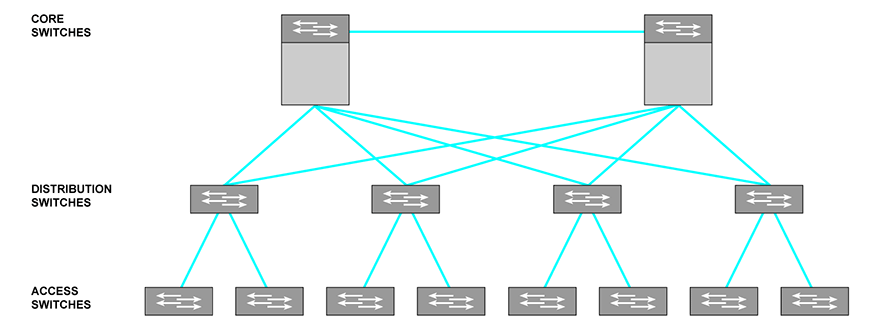The spine-and-leaf network architecture transcends the limitations of the traditional three-tier network architecture, delivering high bandwidth and low latency for server-to-server communications.
A standard method of connecting a spine-and-leaf network employs breakout cassettes and a dense web of fiber cross-connects, but this method increases cable clutter and installation errors. Purpose-built spine-leaf fiber patch panels overcome these challenges.
Traditional network architecture
Traditional data centers use a three-tier network architecture consisting of core switches, distribution/aggregation switches and access (aka top-of-rack or ToR) switches. This architecture is optimized for north-south communication between clients and servers.
The introduction of virtualization and other complex server applications has greatly increased server-to-server communications, however.
The traditional three-tier network architecture is unable to handle this increased east-west traffic efficiently because oversubscription leads to bandwidth bottlenecks and varying end-to-end routes introduce unpredictable latency.
Three tier network architecture is also prone to downtime because the failure of a single upstream switch can interrupt network access downstream.
Traditional network topology

The traditional three-tier network is optimized for north-south, client-server communications. It isn’t ideal for east-west, server-to-server communications– Tripp Lite by Eaton
Spine-and-leaf network architecture
The innovative spine-and-leaf architecture overcomes the limitations of the traditional three tier network architecture, delivering high bandwidth and low latency for server-to-server communications.
In the spine-and-leaf architecture, every lower-level access (leaf) switch is connected to every upper-level core (spine) switch in a full mesh.
Network traffic is evenly distributed among the spine switches, removing bandwidth bottlenecks. And since network traffic always traverses the same number of devices to go from leaf to leaf, latency becomes more predictable and manageable.
Network resilience is also improved, as spine switches are redundant by design and automatically compensate for switch failures. If the network requires more bandwidth, adding spine switches allows it to scale easily. And if more ports are required in the rack, another leaf switch can be added without downtime.
Spine-and-leaf network topology

The spine-and-leaf network delivers high bandwidth and low latency for the increased server-to-server communications required in modern data centers